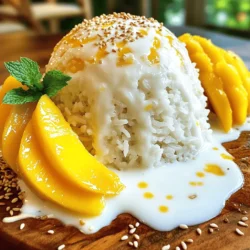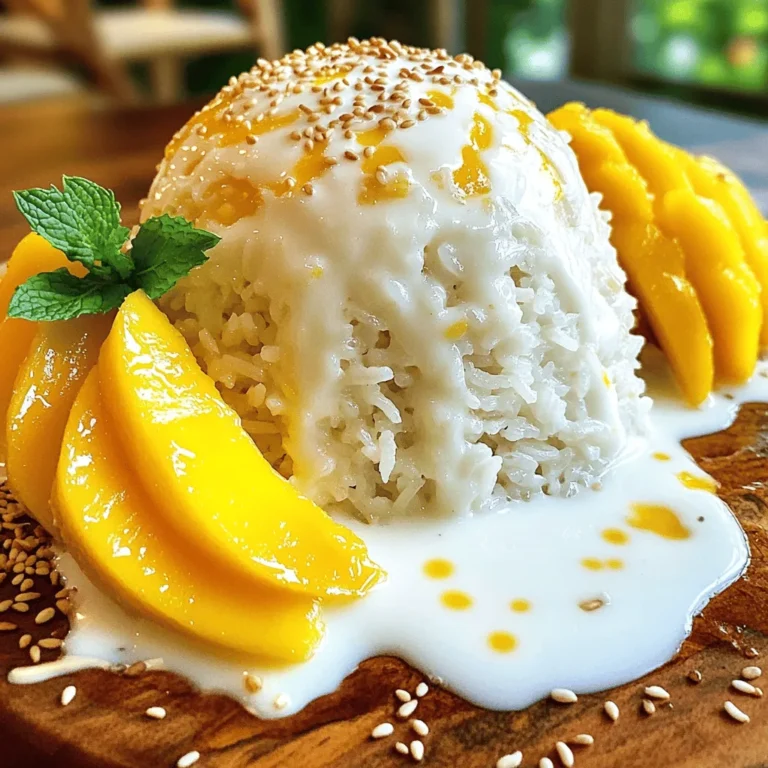If you crave a sweet treat that’s both simple and satisfying, you’ll love Thai Mango Sticky Rice. This classic dish combines creamy coconut sauce with ripe mango and sticky rice, creating a harmony of flavors. In this guide, I’ll share my easy recipe, essential tips, and fun variations. No fancy tools or skills are needed—just a passion for delicious food! Let’s dive into making this delightful dish together.
Ingredients
Main Ingredients for Thai Mango Sticky Rice
To make this tasty dish, you need:
– 1 cup glutinous rice (sweet rice)
– 1 ½ cups coconut milk
– 2 ripe mangoes, peeled and sliced
– ½ cup sugar
– ½ teaspoon salt
Glutinous rice is key for that sticky texture. Coconut milk gives it a rich flavor. The mango adds sweetness and freshness.
Optional Garnishes
You can make your dish even prettier with these garnishes:
– 1 tablespoon toasted sesame seeds
– Fresh mint leaves
These add color and a nice crunch. Mint brings a refreshing touch.
Ingredient Substitutions
If you don’t have glutinous rice, use jasmine rice, but the texture will differ. For sugar, you can swap in honey or agave syrup. If you want a lighter version, use low-fat coconut milk. Just know it may change the taste.
Step-by-Step Instructions
How to Soak the Rice
Start by rinsing the glutinous rice. Use cold water until it runs clear. This step removes excess starch. Next, soak the rice in water. Aim for at least 4 hours. For best results, soak it overnight. This softens the grains and makes them sticky.
Cooking Sticky Rice Perfectly
After soaking, drain the rice well. Next, place it in a steamer. Line the steamer with cheesecloth for easy removal. Steam the rice over boiling water. Cook it for about 20 to 25 minutes. You want the rice to become translucent and tender. Check it halfway through to ensure even cooking.
Making the Coconut Sauce
Grab a saucepan and add 1 cup of coconut milk. Then, mix in the sugar and salt. Heat it over low to medium heat. Stir until the sugar dissolves completely. Avoid boiling the mixture. Set aside the remaining ½ cup of coconut milk for serving later. This sauce will bring creaminess to your dish.
Tips & Tricks
Selecting the Best Ripe Mangoes
Choose mangoes that feel soft when you gently press them. Their color should be bright and vibrant. Look for a slight give at the stem end. These signs show that the mangoes are ripe and sweet. Popular varieties include Ataulfo and Haden. They add great flavor to your mango sticky rice.
Storing Sticky Rice
After cooking, let your sticky rice cool down. Place it in an airtight container. It can stay fresh in the fridge for about three days. For longer storage, freeze the rice in small portions. When ready to use, simply reheat in the microwave or steam it. This keeps the texture lovely and soft.
Enhancing Flavor with Additional Ingredients
You can twist the flavor by adding a pinch of pandan leaf when cooking the rice. This gives a nice aroma. You might also try adding a splash of lime juice to the coconut sauce. It adds a zesty kick. For more crunch, mix in some crushed peanuts or sprinkle them on top. These tweaks make your dish even more exciting!

Variations
Different Types of Mangoes to Use
You can choose different mangoes for this dish. Each type adds its own taste. I love using ripe Ataulfo mangoes. They are sweet and creamy. Haden mangoes are also great. They have a nice balance of sweet and tart. If you want a firmer texture, use Tommy Atkins mangoes. Their flavor is not as strong, but they work well.
Vegan and Dairy-Free Alternatives
You can easily make this dish vegan. Just use coconut milk as your base. It is naturally dairy-free. For sweeteners, try maple syrup or agave nectar. Both add a great touch. If you want a creamier sauce, blend some cashews into the coconut milk. This gives a nice, rich flavor.
Flavor Variations for Coconut Sauce
You can change up the coconut sauce to keep things fresh. Add a splash of pandan extract for a unique twist. It gives a lovely green color and aroma. For a hint of spice, mix in a little bit of ginger. If you prefer a sweeter sauce, increase the sugar. You can even add a bit of lime zest for a citrusy kick. Each change brings a new experience to your mango sticky rice!
Storage Info
How to Store Leftover Sticky Rice
To store leftover sticky rice, let it cool first. Place it in an airtight container. Make sure to keep it at room temperature for up to four hours. After that, refrigerate the rice. It will last for about three days in the fridge. When you’re ready to enjoy it again, you can reheat it.
Reheating Tips for Optimal Texture
To reheat sticky rice, use a steamer if you can. This keeps the rice moist and soft. Steam it for about 10 minutes until hot. If you don’t have a steamer, you can also microwave it. Add a splash of water and cover it with a damp paper towel. Heat it for 30 seconds at a time, checking often.
Best Practices for Storing Mango
Store ripe mangoes at room temperature. They will ripen over a few days. Once ripe, put them in the fridge. This keeps them fresh for up to five days. If you have cut mango, place it in an airtight container. It will stay good for about two days in the fridge.
FAQs
What is the difference between glutinous rice and regular rice?
Glutinous rice is sticky and chewy. Regular rice is fluffy and separate. Glutinous rice has a higher starch content. This makes it perfect for desserts like Thai mango sticky rice. The texture of glutinous rice is what makes this dish stand out. It holds together well, making each bite deliciously satisfying.
Can Thai Mango Sticky Rice be made in advance?
Yes, you can make Thai mango sticky rice in advance. Prepare the rice and coconut sauce a day ahead. Store them separately in the fridge. When ready to serve, simply heat the rice. Slice fresh mango just before serving for the best flavor. This way, you can impress your guests with minimal stress.
What dishes pair well with Thai Mango Sticky Rice?
Thai mango sticky rice pairs well with many dishes. Try it with spicy Thai curries for a nice contrast. It also goes well with grilled meats like chicken or shrimp. You can serve it as a sweet dessert after a savory meal. The balance of flavors will make your meal even more enjoyable.
Thai mango sticky rice combines sweet mango, creamy coconut sauce, and soft rice. You’ve learned about the key ingredients, from selecting ripe mangoes to cooking sticky rice perfectly. We discussed tips for storage and variations to keep your dish exciting.
In the end, this dessert is simple yet satisfying. It’s versatile and perfect for any occasion. Enjoy making your own version and share it with friends and family. Your taste buds will thank you!


